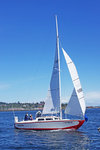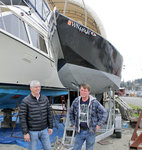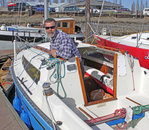Boat lovers may have noticed a gaggle of sister hulls around the Port Townsend Boat Haven lately. In the last five years, the local fleet of Thunderbirds has grown from two or three boats to 14, six …
This item is available in full to subscribers.
We have recently launched a new and improved website. To continue reading, you will need to either log into your subscriber account, or purchase a new subscription.
If you had an active account on our previous website, then you have an account here. Simply reset your password to regain access to your account.
If you did not have an account on our previous website, but are a current print subscriber, click here to set up your website account.
Otherwise, click here to view your options for subscribing.
* Having trouble? Call our circulation department at 360-385-2900, or email our support.
Please log in to continue |
|




Boat lovers may have noticed a gaggle of sister hulls around the Port Townsend Boat Haven lately. In the last five years, the local fleet of Thunderbirds has grown from two or three boats to 14, six to eight of which race regularly, said local T-bird sailor Joe Daubenberger.
Recognizable by their Seahawks-like logo – a profile of a big-beaked bird’s head – and the hulls’ distinctive “hard chine” shape, the 26-foot sloop's design is by Seattle naval architect Ben Seaborn. It came about because of a 1950s competition sponsored by a plywood company.
The original plywood boats – fiberglass ones exist, too – are aging, but there are still a lot of them around, especially here. Port Townsend’s group of Thunderbirds was recently granted fleet status by the International Thunderbird Class Association: Fleet No. 33.
“We are the fastest-growing T-bird fleet in the world right now,” claimed Daubenberger, owner of Dorado, hull no. 242, which his father, Jim Daubenberger, commissioned and brought here in the early 1960s.
“Many of the owners have grown up with these boats, and more than a few have the boats their parents had,” said Joe, who races Dorado with his brother Daubie and nephew Hans Daubenberger.
Sailboats were scarce in PT in the early 1960s, when Dorado and two other Thunderbirds came to town.
Hull no. 243 was built for local attorney Glenn Abraham, who dubbed it Caveat. Hull no. 241, Zaca, belonged to physician Bill Scheyer. Joe Daubenberger said the bill of sale for his T-birds was $3,984.70, including sails and other options.
With four bunks, T-birds are great for family cruising in the Salish Sea, as well as being fun to race.
“They’re really forgiving boats, easy to sail well,” Daubenberger said.
Decades later, Caveat wound up belonging to Port Townsend’s Northwest Maritime Center (NWMC), being used for sailing lessons along with another T-bird, Risa.
Abraham’s daughter Ann, who still lives in PT, wanted her family boat back. Thanks to a recent trade and the collaboration of some folks in the sailing community, she got it.
Zaca was found on Bainbridge Island (by Joe’s brother Daubie). Ann’s husband, Doug Bolling, services manager at Gold Star Marine in Port Townsend, bought and rebuilt Zaca, and then traded it to NWMC for Caveat, which he’s currently rebuilding for himself and Ann.
Zaca has already been sailed by students several times, said NWMC waterfront programs manager Ace Spragg. The two NWMC boats have “subtle differences,” she added: Zaca has a roller-furling jib and a traveler, while Risa has no traveler and a hank-on jib. The boats fit about six people, Spragg said.
PROJECT BOATS
In the yard next to Gold Star Marine is yet another T-bird, this one with no name, but the black hull is no. 105. Abandoned at anchor in Port Ludlow, it was recently purchased by Joe Daubenberger and is Bolling’s next project.
Bolling also recently rebuilt Raven, an all-fiberglass T-bird owned by Stig Osterberg and Steve Scharf that sports a blindingly shiny black finish.
All T-bird hulls have a fiberglass coating, but most are plywood underneath. Some owners extend the life of a boat by topping the plywood hull with a molded fiberglass deck, like a lid. Other T-birds are made entirely of fiberglass. There are four of those in PT: Raven, Blewbird, Kolus and Kuma San.
The Townsend T-bird fleet also includes Anuket, Boreas, Coco Solo, Rowdy and Thatuna.
For “years and years,” Daubenberger said, Scott Walker has owned Tzieu, whose name “is supposed to be the sound of an arrow leaving a bow.”
“We put a lot of our attention to sailing fast ... trying to,” said Piper Dunlap, who races T-birds as well as Etchells 22s and high-performance 505 dinghies. “We have the disease pretty bad.”
Of Thunderbirds, Dunlap said, “The beauty of them is the bang for the buck.” Dunlap co-owns, with Dan Ginther and Lucas Hurt, a fiberglass-hulled T-bird he imported from Chesapeake Bay. (It came with a trailer, and his brother towed it here.) The Aegean-blue Blewbird, built in 1979 by Booth Enterprises in Victoria, British Columbia, has a history of winning races, including the 2005 international T-bird championship. “We knew it was a fast boat,” Dunlap said, although “they’re all theoretically the same.”
Also, Blewbird “came with so many good sails,” Dunlap said, including three spinnakers. In racing, sails are a big expense, he said, and better sails can help win races.
WHITECAP SERIES
Competition is going to be fierce, in a gentlemanly way, between the T-birds and others in the Spring Whitecap Series, which are Friday-evening races organized by the Port Townsend Sailing Association (PTSA) that begin on March 20. The starting line is usually the anchored race committee boat; “occasionally they may be started from City Dock,” Dunlap said. Denizens of happy-hour decks may take note: Races begin promptly at 6:30 p.m.
Those who are interested in sailing as a crew member are invited to a skippers’ meeting at 6 p.m., Thursday, March 19 at NWMC. The race committee is to go over local sailing instructions, “all the information you need to successfully sail races,” Dunlap said, including procedures for the start, how finishes will be recorded and an explanation of the course, which is different each time, and communicated to skippers via a large placard set up on the committee boat, anchored out during races.
Osterberg has been sponsoring racing seminars for skippers, which cover the local “sailing instructions” specific to PT races as well as the international “racing rules of sailing.” See ptsail.org.
“Our goal is to bring our entire fleet up the ladder,” improving the boats as well as the skills of the crew, Daubenberger said.
“It’s a mystery what makes a boat fast,” Dunlap said. “People will argue about it for hours.”
“It’s always the people that make the boats fast,” Joe Daubenberger said, along with “a really clean bottom, and smooth. And then, sails.”